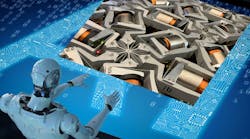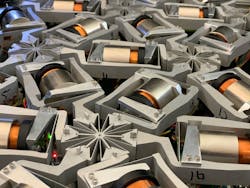UCLA engineers have designed a material that can adapt to changing conditions.
The material consists of tunable beams that can dynamically adjust its behavior to suit changes in its environment, including “rising levels of internal damage, varying fixturing scenarios and fluctuating external loads,” according to a paper published in Science Robotics.
The experimental study lays the foundation for AI materials that can be applied in the construction of buildings, airplanes and imaging technologies, noted the authors.
“This research introduces and demonstrates an artificial intelligent material that can learn to exhibit the desired behaviors and properties upon increased exposure to ambient conditions,” said mechanical and aerospace engineering professor Jonathan Hopkins of the UCLA Samueli School of Engineering who led the research. “The same foundational principles that are used in machine learning are used to give this material its smart and adaptive properties.”
Features
The material can be likened to the way artificial neural networks (the algorithms that drive machine learning) tune their weights. The material’s “mechanical neural networks” (MNNs) are capable of learning to tune the stiffness of their constituent beams, explained the authors.
The individual beams of the MNNs are organized in a triangular lattice pattern. Each beam features a voice coil, strain gauges and flexures. These features “enable the beam to change its length, adapt to its changing environment in real time and interact with other beams in the system,” noted the researchers.
In one example, the researchers describe how the material might be used in aircraft wings. The material might learn to morph the shape of the wings to adapt to patterns wind patterns during a flight as a way to improve efficiency and maneuverability. They noted that it is also conceivable that the material can help improve rigidity and overall stability in infrastructure applications, where earthquakes or natural and manmade disasters pose a risk.
The voice coil is used to initiate a fine-tuned compression or expansion in response to forces placed on the beam. The strain gauge collects data from the beam’s motion used in the algorithm to control the learning behavior. The flexures connect the moveable beams to the system.
The system is further supported by an optimization algorithm which regulates the system. It harnesses data from the strain gauges in order to determine a configuration of rigidity values that will control the network, explained the authors. Cameras were trained on the output nodes of the system in order to validate the actions taken by the strain gauge-monitored system.
The system is about the size of a microwave oven, but the researchers plan to simplify the MNN design so that thousands of the networks can be manufactured on the micro scale within 3D lattices for practical material applications.
Other applications suggested for the use of MNNs include the incorporation into an armor to deflect shockwaves, as well as in acoustic imaging technologies to harness soundwaves.


